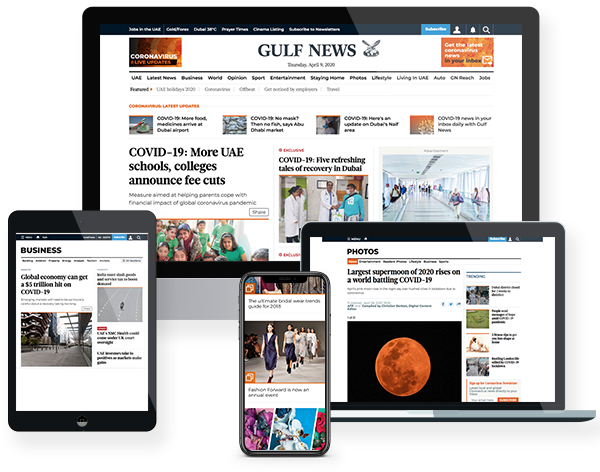
Dubai: On the edge of the Empty Quarter, hidden and forgotten for thousands of years, lie the remains of an ancient trading post – a city that traded with the ancient kingdoms of Egypt, Mesopotamia and India, with foundries producing exquisitely designed ornaments and weaponry. A thriving oasis in desert. A meeting place of cultures and ideas.
The archaeological discoveries at the 3,000-year-old Iron Age settlement of Saruq al Hadid - on the outskirts of Dubai - are rewriting the history of the Emirates – and the region. But its secrets would have remained just that for years, if not centuries, had it not been for an improbable stroke of luck.
Something unsual in the sands
In 2002, His Highness Sheikh Mohammed Bin Rashid Al Maktoum, Vice President and Prime Minister of the UAE and Ruler of Dubai, was flying over an area of the desert approximately 80km south of Dubai when he saw something unusual. Sand dunes stretched as far as the eye could see – except for one small area. In the sea of yellow were dunes covered with what looked like small black stones. A team of archaeologists from the Dubai Municipality was ordered to investigate.
“When I came here it was a big mystery,” said Dr Mansour Boraik, Chief Archaeologist at the Architectural Heritage and Antiquities Department (AHAD), Dubai Municipality, describing his first visit. “You are in front of a big site, a huge site, and I said ‘Oh my God.’ It was a big challenge for us.”
The stones turned out to be slag from copper and iron smelting. As teams of archaeologists went to work, it soon became apparent that the site had flourished during the Iron Age, around 1,000 BCE. What is now a desert was once a rich, thriving oasis city.
New documentary
The story of the discovery of this ancient site and its importance for understanding the deep and rich history of the Emirates is the subject of a documentary ‘Saruq al Hadid: Dubai’s Iron Age’, which premiered at Expo 2020 Dubai on Sunday. A collaboration between Expo 2020 Dubai, Image Nation and Atlantic Productions, it will be available to watch on Expo 2020’s Youtube channel, Expo TV and Virtual Expo, from Monday onwards.
“For Sheikh Mohammed to be flying over the desert in his helicopter and to see strange things in the sand, for those little scars in the landscape to become something that we understand, and then to go below and understand what was there – it’s incredible,” said Anthony Geffen, CEO and Creative Director Atlantic Productions. “History peels back to reveal things that we had no idea were there.”
The documentary’s director Lina Zilinskaite recalls being “intrigued” when she got a call from Atlantic Productions about a proposed documentary, because it seemed unimaginable that such a site could exist so close to Dubai.
“When we think about ancient great civilisations, our minds immediately go to Egypt, Mesopotamia, Greece,” Zilinskaite says. “What I found incredibly rewarding working on this project was showing that the ancient world was much richer and much more diverse than people think and that there were other cultural centres, other major civilisations at the time that were hubs of cultural activity, of trade and of exchange.”
The ring behind the logo
More than 23,000 artifacts have been excavated at the Suruq Al Hadid site. Exquisitely carved daggers, copper and bronze axe heads, arrowheads, models of snakes, ceramics and ornate jewellery reveal the story of a highly advanced civilisation that traded extensively with the region.
But one object would tell an even more important story. During excavations conducted in 2008 and 2009 by the Dubai Desert Survey, archaeologists discovered a solid gold ring that had been cast in beeswax. Instead of being worn on a finger, the ‘ring’ was linked with others to form a necklace.
“From all the thousands of items found at the site, the artefact that resonated with Sheikh Mohammed was not a mighty sword or a giant piece of earthenware, but a tiny gold ring,” said Reem Al Hashimy, Minister of State for International Cooperation and Director-General of Expo 2020 Dubai.
That ring became the basis for Expo 2020 Dubai’s now-familiar logo which was unveiled by Sheikh Mohammed at a ceremony in 2016, where it was projected in gold light on to the Burj Khalifa.
“When we were searching for a logo for Expo, coming across the ring was like a gift from history and a gift from our nation,” said Dr Hayat Shamsudddin, Senior Vice President, Arts & Culture, Expo 2020 Dubai. “The ring is very much a symbol of representing the past, linking it with the present and taking us to the future. On its own the ring is breathtaking, but when you put many, many pieces together, it’s something even more beautiful.”
Shrouded in mystery
While there is no doubt Saruq Al Hadid was one of the most important trading hubs in the region, much about the people who lived there, their religion and culture remains a mystery. “I would say only two per cent has been excavated,” said AHAD archaeologist Mahra Al Mansoori. “Saruq al Hadid is a very big area and we are working square by square. We still have not found the houses of the people who lived there. It will probably take 20 years to answer all our questions about what is there.”
The site’s location, far from sources of timber needed to create charcoal for its kilns and the seaports it relied on for trade, has also puzzled archaeologists. Sculptures showing camels carrying saddles, pots and people dating from the first millennium BCE provide at least part of the answer by confirming the animal was domesticated during the Iron Age and used to transport goods across the vast deserts and along the Silk Roads linking Saruq Al Hadid to distance markets in Asia and the Middle East.
Another clue to the origins of Saruq Al Hadid are hundreds of models of snakes forged in copper and bronze found at the site. “All the models were made to look like they were moving on the ground,” said Dr Boraik. “The models of the snakes give us an idea that Saruq Al Hadid was a very important religious place where they were doing some ceremonies and worshipping the snake.” Importantly, carvings of snakes found as far east as Wadi Saham in the Hajar mountains of Fujairah, provide the earliest evidence of cultural unity in the Emirates going back 3,000 yeaPara
Parallels with modern-day Dubai
“If we compare … the vast trade of the people of Saruq Al Hadid in ancient times and compare it with today, Dubai now is one of the main cities of trade – it’s exactly the same,” said Dr Boraik. “It’s very nice to connect between the ancient and the modern history of Dubai.”
For Dr Hayat, Saruq Al Hadid’s role in opening the region to the wider world shows that the Emirates has always been a meeting point for civilisations – and that has important lessons for creating a better future for all.
“What we can learn from Saruq Al Hadid is that really the best way to move forward in preserving our planet and helping us have a better future for us, [and] for our generations to come, is to collaborate. One person may be able to do quite a bit, but many people and many nations coming together can really find solutions. When we come together, we can make for a better world and we really, really need that.”










